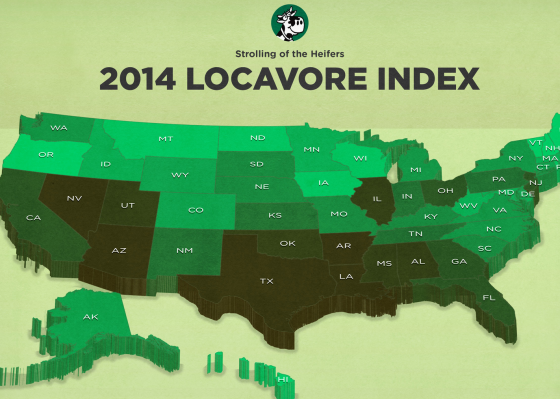Posted July 1, 2014 at 07:09am by Martin Langeveld
Vermont leads the nation in the Strolling of the Heifers Locavore Index

Strolling of the Heifers, the Vermont-based local food advocacy group best known for its annual parade and festival celebrating local farms and local food, has released its third annual Locavore Index, a state-by-state ranking of commitment to local foods.
By compiling the Index, Strolling of the Heifers hopes to strengthen local farms and food systems by encouraging efforts across the country to increase the use of local foods in homes, restaurants, schools and institutions.
The 2014 Locavore Index incorporates four measures for which current data is available for all states: the number of farmers markets, the number of consumer-supported agriculture operations (CSAs), the number of food hubs — all compared on a per-capita basis — plus the percentage of each state’s school districts with active Farm-to-School programs. But more data on local foods should be gathered, Strolling of the Heifers says.
“For all the attention that locavorism has received in recent years, reliable and consistent state-by-state statistics on local food consumption are hard to come by,” said Orly Munzing, founder and executive director of Strolling of the Heifers “If we all agree that growing, buying and eating local foods is good, then we need to do a better job of measuring it,” Munzing said.
The Index says the top three states for locavorism, are (in order) Vermont, Maine and New Hampshire, rankings that are unchanged from last year. Oregon moved up to fourth place (from seventh in 2013), and Hawaii came in fifth (from 13th in 2013). Rounding out the top 10 were Rhode Island, North Dakota, Wisconsin, Montana and Iowa.
“This ranking reflects the commitment Vermonters have made to community based agriculture,” said Chuck Ross, Vermont’s Secretary of Agriculture, Food and Markets. “From the farm and food system entrepreneurs who are providing local foods, to the schools and institutions that are stepping up to integrate local foods, to the individual Vermonters who are making healthy, local choices, our state has embraced a systems approach to agriculture.”
Along with the Index, Strolling of the Heifers released its list of 10 reasons to increase the use of local foods, stressing that local foods are more sustainable, healthier, better for the environment and economically positive than foods sourced from large-scale, globalized food systems.
Strolling of the Heifers’ 10 reasons to consume local foods:
- Supports local farms: Buying local food keeps local farms healthy and creates local jobs at farms and in local food processing and distribution systems.
- Boosts local economy: Food dollars spent at local farms and food producers stay in the local economy, creating more jobs at other local businesses.
- Less travel: Local food travels much less distance to market than typical fresh or processed grocery store foods, therefore using less fuel and generating fewer greenhouse gases.
- Less waste: Because of the shorter distribution chains for local foods, less food is wasted in distribution, warehousing and merchandising.
- More freshness: Local food is fresher, healthier and tastes better, because it spends less time in transit from farm to plate, and therefore loses fewer nutrients and incurs less spoilage.
- New and better flavors: When you commit to buy more local food, you’ll discover interesting new foods, tasty new ways to prepare food, and a new appreciation of the pleasure of each season’s foods.
- Good for the soil: Local food encourages diversification of local agriculture, which reduces the reliance on monoculture — single crops grown over a wide area to the detriment of soils.
- Attracts tourists: Local foods promote agritourism — farmers markets and opportunities to visit farms and local food producers help draw tourists to a region.
- Preserves open space: Buying local food helps local farms survive and thrive, keeping land from being redeveloped into suburban sprawl.
- Builds more connected communities: Local foods create more vibrant communities by connecting people with the farmers and food producers who bring them healthy local foods. As customers of CSAs and farmers markets have discovered, they are great places to meet and connect with friends as well as farmers!
